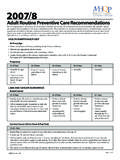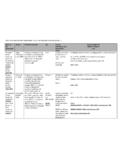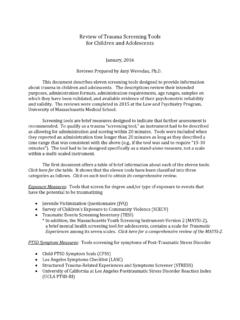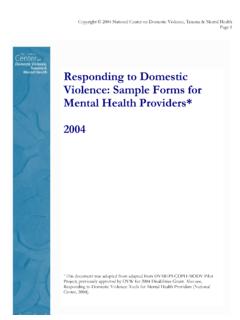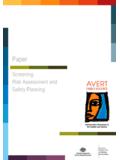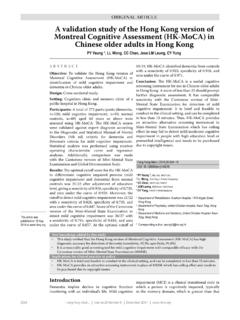Transcription of Institute for Health and Recovery
1 Institute for Health and Recovery Integrated screening Tool Women s Health can be affected by emotional problems, alcohol, tobacco, other drug use, and domestic violence. Women s Health is also affected when those same problems are present in people close to us. By alcohol, we mean beer, wine, wine coolers, or liquor. Parents Did any of your parents have a problem with alcohol or other drug use? YES NO Peers Do any of your friends have a problem with alcohol or other drug use? YES NO Partner Does your partner have a problem with alcohol or other drug use?
2 YES NO Violnece Are you feeling at all unsafe in any way in your relationship with your current partner? YES NO Emotional Health Over the last few weeks, has worry, anxiety, depression, or sadness made it difficult for you to do your work, get along with people, or take care of things at home? YES NO Past In the past, have you had difficulties in your life due to alcohol or other drugs, including prescription medications? YES NO Present In the past month, have you drunk any alcohol or used other drugs?
3 1. How many days per month do you drink?_____ 2. How many drinks on any given day? _____ 3. How often did you have 4 or more drinks per day in the last month? _____ YES NO Smoking Have you smoked any cigarettes in the past three months? YES NO Advise for Brief Intervention Y N NAAt Risk Drinking Did you State your medical concern? Did you Advise to abstain or reduce use? Non-PregnantPregnant/ Planning Pregnancy Did you Check patient s reaction?
4 Did you Refer for further assessment? > 7 drinks / week > 3 drinks / day Any Use is Risky Drinking Date: Language: Race: For the best Health of mothers and babies, we strongly recommend that pregnant women, or those planning to become pregnant, do not use alcohol, illegal drugs or tobacco. Safe levels of usage have not been determined. Ethnicity: ReviewRisk ConsiderMental Health Evaluation Review Substance Use, Set Healthy Goals ReviewDomestic Violence Resources 2005 Rationale for Utilization of the 5P'S The Institute for Health and Recovery s Integrated 5 P'S screening Tool is based on Dr.
5 Hope Ewing's 4 P's (Parents, Partner, Past and Pregnancy)1, and was designed specifically for pregnant women. The 4 P's have been adapted by IHR, and, in another iteration, by Dr. Ira Chasnoff of the Children's Research Triangle (see below). IHR has utilized the 5 P'S successfully in six years of the Alcohol screening Assessment in Pregnancy Project, and in 18 months of the Fetal Alcohol screening for Today An article describing our utilization of the 5 P'S in prenatal settings was recently published in the Maternal and Child Health The IHR 5 P'S was developed through funding by the Maternal and Child Health Bureau for the ASAP Project and is in the public domain.
6 We have chosen the 5P'S for its simple structure and its relational base. It is a quick, easy, non-threatening, and effective tool for use in busy, resource-challenged prenatal care offices. It effectively asks a pregnant woman about her own use of alcohol in a nonjudgmental manner. For women at risk for use or not yet ready to report their own use, the 5P'S asks about alcohol and other drugs by people who are most likely to be important in a woman s life: her Partner and her Parents3. Research has shown that women who are in relationships with partners or have parents who have alcohol/drug problems are more likely to use themselves4 and are also at risk for other medical concerns, such as infectious The 5P S also encourages a woman to report a Past or Present problem with alcohol.
7 The instrument opens the door to a possible conversation about a patient s current alcohol or drug use, her past use, or use among people in close relationship to her. Each "P" and/or Smoking represents a documented risk for substance use during pregnancy. The 5 P'S can be embedded into existing office forms, used as part of a fuller pregnancy needs assessment as a self-administered written questionnaire (SAQ), or included in electronic medical records. In ASAP, the 5P s were asked in a specific order that started with a question about someone else s alcohol use (Parents). Each subsequent question brought the issue of alcohol use closer to the pregnant women (Peers, Partner) until the last two questions asked about the patient s Past and use during this Pregnancy (present).
8 This sequence was established to be as non-threatening as possible. Each of the risk assessment tools utilized in ASAP asked an additional question about tobacco use because of the documented link between pregnant women s tobacco and alcohol , 7 Using the 5P S, including the tobacco use question, of the pregnant women screened in ASAP over the first three years had at least one risk factor; the percentage has increased to 47% in more recent years. Most of those patients who screened in responded positively to the questions regarding tobacco use (ASAP1:58% community Health centers, 45% private practices) and parental alcohol problem (31% community Health centers, 12% private practices).
9 ASAP2 figures are currently being analyzed. In accordance with the ASAP protocol, if a pregnant woman responded positively to any of the 5P S or the tobacco use question, she would also receive a brief intervention. Implementation protocols for the 5 P S may be found in Alcohol screening Assessment in Pregnancy: The ASAP Curriculum8, written and edited by the Institute for Health and Recovery . Project FAST proposed to reduce the number of questions that can result in a positive screen at the request of prenatal care staff from ASAP sites. Prenatal staff felt that "parental" and "peer" use was less indicative of risk than "partner," "past," "present," or "tobacco," and that fewer positive responses resulted in the time savings of few brief interventions.
10 As time issues are of paramount importance to medical staff, ASAP flexibility was an important factor in keeping busy prenatal sites engaged in the project. Positive responses to "parental" and "peer" indicate that a woman is at risk of alcohol use and prenatal staff use this opportunity to discuss risk with them. 2In ASAP 1, a consultant conducted interviews with both patients who had completed the risk assessment with the 5P's embedded and with prenatal care staff at participating sites. Patient interviews found that when patients were asked about the 5P S, they reported that they felt the set of questions was appropriate and understood them to be Health related.
